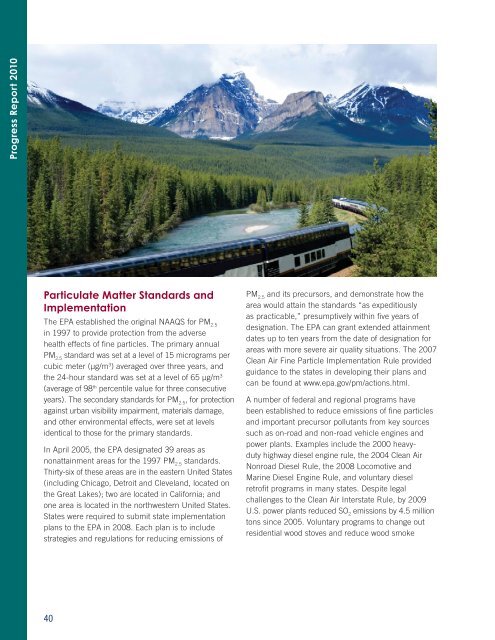2010 Progress Report - International Joint Commission
2010 Progress Report - International Joint Commission
2010 Progress Report - International Joint Commission
Create successful ePaper yourself
Turn your PDF publications into a flip-book with our unique Google optimized e-Paper software.
<strong>Progress</strong> <strong>Report</strong> <strong>2010</strong><br />
Particulate Matter Standards and<br />
Implementation<br />
The EPA established the original NAAQS for PM 2.5<br />
in 1997 to provide protection from the adverse<br />
health effects of fi ne particles. The primary annual<br />
PM 2.5<br />
standard was set at a level of 15 micrograms per<br />
cubic meter (μg/m 3 ) averaged over three years, and<br />
the 24-hour standard was set at a level of 65 μg/m 3<br />
(average of 98 th percentile value for three consecutive<br />
years). The secondary standards for PM 2.5<br />
, for protection<br />
against urban visibility impairment, materials damage,<br />
and other environmental effects, were set at levels<br />
identical to those for the primary standards.<br />
In April 2005, the EPA designated 39 areas as<br />
nonattainment areas for the 1997 PM 2.5<br />
standards.<br />
Thirty-six of these areas are in the eastern United States<br />
(including Chicago, Detroit and Cleveland, located on<br />
the Great Lakes); two are located in California; and<br />
one area is located in the northwestern United States.<br />
States were required to submit state implementation<br />
plans to the EPA in 2008. Each plan is to include<br />
strategies and regulations for reducing emissions of<br />
PM 2.5<br />
and its precursors, and demonstrate how the<br />
area would attain the standards “as expeditiously<br />
as practicable,” presumptively within fi ve years of<br />
designation. The EPA can grant extended attainment<br />
dates up to ten years from the date of designation for<br />
areas with more severe air quality situations. The 2007<br />
Clean Air Fine Particle Implementation Rule provided<br />
guidance to the states in developing their plans and<br />
can be found at www.epa.gov/pm/actions.html.<br />
A number of federal and regional programs have<br />
been established to reduce emissions of fi ne particles<br />
and important precursor pollutants from key sources<br />
such as on-road and non-road vehicle engines and<br />
power plants. Examples include the 2000 heavyduty<br />
highway diesel engine rule, the 2004 Clean Air<br />
Nonroad Diesel Rule, the 2008 Locomotive and<br />
Marine Diesel Engine Rule, and voluntary diesel<br />
retrofi t programs in many states. Despite legal<br />
challenges to the Clean Air Interstate Rule, by 2009<br />
U.S. power plants reduced SO 2<br />
emissions by 4.5 million<br />
tons since 2005. Voluntary programs to change out<br />
residential wood stoves and reduce wood smoke<br />
40
















